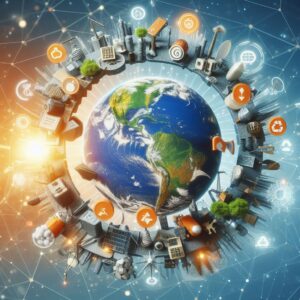The concept of a circular economy, aimed at minimizing waste and promoting sustainable resource use, has become increasingly prominent in the global quest for environmental preservation. Circular economy technologies are spearheading innovative solutions that challenge the traditional linear model of production and consumption, emphasizing the reduction, reuse, and recycling of resources.

Innovations in Waste Reduction
Circular economy technologies are revolutionizing waste reduction strategies across industries. Advanced recycling technologies enable the recovery of valuable materials from discarded products, diverting them from landfills and reintroducing them into the production cycle. Additionally, waste-to-energy technologies harness the energy potential of waste, generating electricity or heat from organic materials.
Promoting Reuse and Remanufacturing
Technological advancements are promoting the reuse and remanufacturing of products, extending their lifecycle and reducing the need for raw materials. Furthermore, digital platforms and technologies facilitate the sharing economy, encouraging the exchange, rental, or resale of goods.
Closing the Loop: Circular Supply Chains
Circular economy tech is reshaping supply chains by promoting closed-loop systems. Blockchain technology, for instance, enhances traceability and transparency in supply chains, ensuring the authenticity and origin of recycled materials. By tracking materials from collection to reprocessing and reuse, it establishes trust and incentivizes sustainable practices among stakeholders, paving the way for more sustainable and ethical sourcing.
Challenges and Future Prospects: Embracing Circular Economy Tech
Despite the strides made, challenges persist in the widespread adoption of circular economy technologies. Barriers include technological limitations, economic viability, and cultural shifts in consumer behavior and industry practices. However, the continuous innovation and collaborative efforts among industries, policymakers, and researchers indicate promising prospects. As circular economy technologies evolve and gain momentum, they hold the potential to redefine production and consumption patterns, driving a transition towards a more sustainable and resource-efficient global economy.
The rise of circular economy technology marks a pivotal shift in our approach to resource utilization, advocating for a sustainable model that prioritizes waste reduction and resource efficiency. These innovative technologies are instrumental in challenging the traditional linear model of production and consumption, aiming to create a closed-loop system. Advanced recycling methods stand as a cornerstone of this movement, enabling the recovery of valuable materials.
Moreover, circular economy technologies promote the ethos of reuse and remanufacturing, stretching the lifecycle of products and minimizing the demand for virgin resources. Additive manufacturing, such as 3D printing, emerges as a key enabler, facilitating the creation of spare parts. The advent of digital platforms further fuels the sharing economy, encouraging the exchange.

While these innovations promise transformative change, hurdles in widespread adoption persist. Challenges encompass technological constraints, economic feasibility, and the imperative for a cultural shift in consumer behaviors and industrial practices. Nevertheless, ongoing innovation and collaboration across sectors fuel optimism, indicating a trajectory toward a more circular and sustainable economic paradigm. As circular economy technologies evolve and gain traction, they hold the potential to revolutionize our approach to resources.
Conclusion: Embracing Circular Economy Tech
Circular economy technologies represent a transformative shift towards a regenerative and sustainable economic model. These innovations not only address waste management challenges but also offer solutions to conserve natural resources and reduce environmental degradation. Embracing and scaling these technologies will be pivotal in transitioning towards a more circular and sustainable future.
For more Article like this, visit our Website Here
